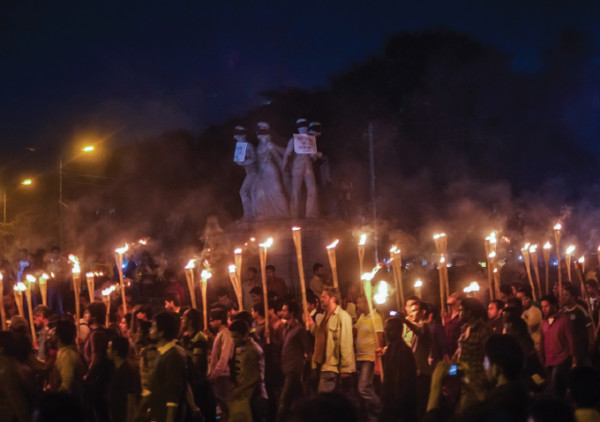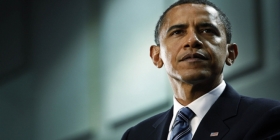In Pic :The young protesters at Dhaka may not be radical chic, but they deserve our cheers
WHY DID India react with such tepidness and defensiveness to the Shahbag Square protests in Bangladesh? The reference here is not so much to the response of the Ministry of External Affairs (MEA) as to civil society, the media and intelligentsia.
The government was correct but concise in its approach and its support of “the capacity for political mobilisation and open-mindedness of Bangladeshi youth” — to borrow National Security Adviser Shiv Shankar Menon’s words. The MEA could not have done much more. It was worried, and legitimately so, that open support to the Shahbag protesters would lead to the Jamaat-e- Islami labelling them (the protesters) an Indian fifth column in Bangladesh.
Indeed, following the surge of popularity for the Shahbag protests, the Jamaat sought to hit back by diverting the issue and questioning the credibility of the students. The latter were labelled atheists and anti-Islamic, when in reality many of them appeared to be devout, practising Muslims. Attacks on Hindus, a small minority in Bangladesh today, also began and were clearly aimed at provoking larger religious and nationalist fires. The Jamaat was praying for a strong statement from or backlash in India, which it would then use to marginalise the Shahbag protesters.
That was the framework in which the government and the MEA operated. What of civil society? Initially, media coverage in India of the Shahbag protests was practically non-existent. Part of the reason for this is the obsession of New Delhi’s political and media elites with Pakistan. In contrast, other neighbours are discounted. Bangladesh, a country that has made dramatic socio-economic progress in recent years, is more or less ignored. Nor was the western media picking up the story, and so Indian television cavalcades did not see the need to jump on a flight and play catch up. It was quite startling. Indian reporters had travelled to Benghazi and Tahrir Square, to Karachi and Kabul, but Shahbag Square, Dhaka, was a no-go area. One channel did do an early report. TEHELKA sent a reporter for a cover story. Other than that, there was largely silence.
Why? A significant body of young Bangladeshis was taking on and not joining hands with the Islamists. These young people were seeking to reclaim national and cultural identity from a purely religious prism. This was a Muslim youth bulge of quite another kind. Why was nobody welcoming it?
When the finger points to the moon, an old Chinese proverb has it, the idiot points to the finger. Somehow, in media circles and among the human rights fraternity, the buzz was heard that the Shahbag crowds were illiberal because they were demanding the death penalty. This was deemed offence enough for an informal underplaying of the Shahbag movement and an attempt to undermine its importance. It was to miss the wood for the trees. The fundamental debate on the streets of Shahbag was not about the death penalty; it was about what sort of country Bangladesh would be.
THE DEATH penalty is a problematic and contested phenomenon. In many societies, and not just those of the West, its gradual removal and infrequent use — if not its outright abolition — has come to be seen as a measure of human evolution and a refined juridical sensibility.
In India, the death penalty has been repeatedly debated in recent times — in the aftermath of the horrific rape of 16 December 2012; following Afzal Guru’s execution; and most recently, after President Pranab Mukherjee turned down the mercy petition of accomplices of the late bandit Veerappan. These men had been convicted of killing policemen about 20 years ago.
Should the death penalty exist? If it is to be used only in the rarest-of-rare cases, how does one benchmark such cases? Is the rarest-of-rare criterion deployed evenly in judicial verdicts in India? Should there be a time limit to processing mercy petitions and commuting or undertaking the sentence of a convict on death row? These are all valid questions. On the face of it, hanging a person for a crime committed two decades ago seems awkward and unfair. In Bangladesh, there is a demand to hang Jamaat members for war crimes committed four decades ago. In an abstract, antiseptic context, the opponents of the death penalty could have a point.
However, Shahbag is not and never was a sterile salon. It represents a wrenching, possibly iconic struggle between young Bangladeshis opposed to the Jamaat — and perhaps sympathetic to the Awami League — and other young Bangladeshis who are adherents of the Jamaat. This is happening in a country with among the world’s largest populations and youngest demographic profiles. Its implications are enormous. The young people and the binaries clashing at Shahbag are not arguing over history; they are seeking to grasp the future — a future that could go one way or the other. Whether the death penalty should or shouldn’t exist is not even a side-issue in this clash.
On the other hand, those who make the death penalty the near unifocal obsession don’t just miss the point, they act with supreme fecklessness. They end up providing a handle to fellow travellers of the Jamaat — including the Jamaat-e- Islami Hind, which has issued a press release “lament(ing) the death sentence… as cruelty and injustice” and arguing the Bangladesh Jamaat’s “different views” on the 1971 war “cannot be called a crime”. The upshot is there for us to see: diffidence begets denialism. The fact is the Jamaat in East Pakistan was an auxiliary of the Pakistan Army in the massacre of countless Bengali-speaking citizens in 1970-71.
IN THE end, the decision is for Bangladesh to take. Shahbag represents a conversation or, more correctly, a heated argument that country is having with itself. India or anybody else cannot intervene or step in. The world community can demand the Bangladeshi State look after its minorities and prevent further attacks on Hindus. It can counsel the Jamaat not be banned; as the case of the Muslim Brotherhood in Egypt or even the rigged 1986 election in Jammu & Kashmir suggest, when you artificially constrict political space for the Islamic right, you only end up strengthening it.
More than anything else, however, the world community can take the morally correct position and just state its preferences. Simply because the young people at Shahbag are not radical chic, mouthing progressive slogans and advocating postmodernist causes, doesn’t mean they are not worthy of backing. Let us be realistic about the choices on offer. If the Jamaat wins the day, it could take Bangladesh closer to the sort of country Pakistan is. The alternative is the sort of country Indonesia is.
A decade after the Bali bombings and after a gruelling struggle against the Jemaah Islamiyah (JI) terror network, Indonesia has picked itself up. Its economy is growing, and it is far from being an Islamist State — as was feared at the height of the JI paranoia. Nevertheless, it is a much more visibly Muslim society than say 20 or 30 years ago. The sheer number of mosques, the adherence to the symbols of the faith (such as the veil or the headscarf ): all this is more noticeable.
Something similar will probably happen in Bangladesh. To counter the Jamaat propaganda that they are deracinated, atheistic and hostile to Islam, the young people at Shahbag will perforce wear their religious identity on their sleeves. They will stand up for their interpretation of what the Prophet taught. Their charter may not always mirror the proceedings of a Human Rights Watch seminar in New York or an op-ed article in The Guardian or a politically correct discussion conducted between an academic, an activist and a journalist on Indian news television. Never mind; those students are still worth cheering.
Shahbag still deserves a Salaam.






Leave a reply